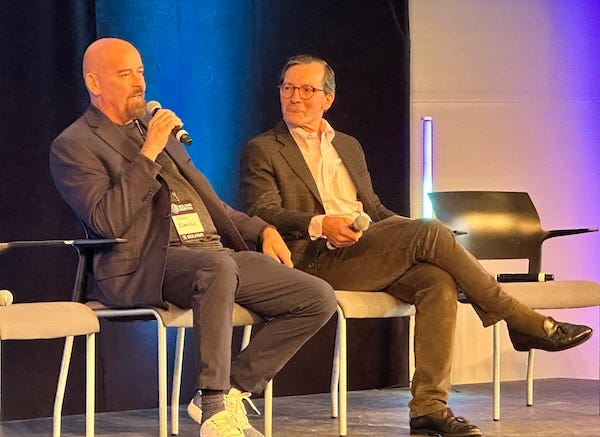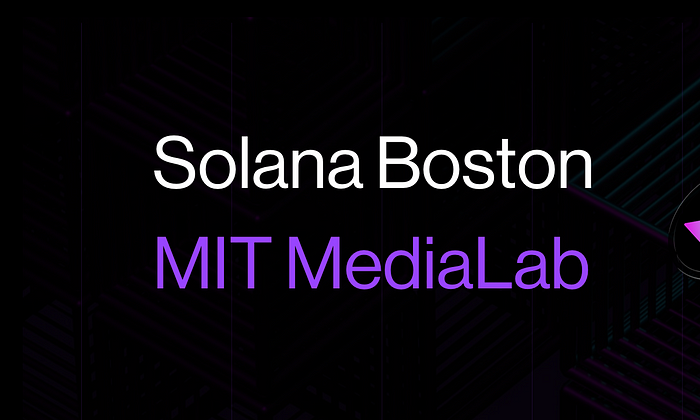Insights from the Solana Boston Conference: Emerging Technologies, Innovation and Institutional Adoption

I had the opportunity to attend the inaugural Solana Boston Conference, which showcased a series of insightful panels and discussions from thought leaders across the crypto ecosystem. Not only was this the first Solana Boston conference, it was the first ever city conference for Solana. They talked about adding additional cities soon. I am actually a relative newcomer to the Solana Ecosystem with no investment to speak of at this time. I went to learn and connect with people building on the ecosystem both were easily accomplished. Overall I found the community very open and welcoming. The MIT Media lab was a great venue and the Solana team who partnered with mostly the Boston DAO (with probably some others) put on an excellent event.
The focus ranged from institutional adoption and cutting-edge technologies to real-world applications of Solana, demonstrating the significant progress Solana has made as both a blockchain and as an economic ecosystem. There were a number of great talks, while I couldn’t attend them all here are the highlights from some of the key sessions I did attended.
Institutional Panel: Embracing Digital Assets in TradFi
Speakers: Ryan Lessard (Fidelity), Perry Woodin (Node40), Hadley Stern (Marinade)
Moderator: Keli Callaghan (Arrington Capital)
The institutional panel began with Ryan Lessard from Fidelity, who shared how their digital asset journey started in 2014, now offering both trading and custody services for digital assets. He highlighted a noticeable shift in the sophistication of their investor base. While investors once dismissed crypto, they now seek education and ask more informed questions about assets like Bitcoin and Ethereum. Despite the growing interest, challenges persist, especially for funds like pensions, which are restricted from purchasing spot BTC or ETH due to regulatory limitations. However, new financial products like ETFs are opening doors to broader exposure.
Lessard acknowledged that while Fidelity aims to expand its digital asset offerings, the process is slow due to the nature of TradeFi. A 90-year-old institution may not prioritize a nine-year-old digital asset, and integrating these assets into an already complex tech stack takes time. Still, he believes it’s becoming increasingly rare to find large institutions that aren’t experimenting with digital assets, particularly with the tokenization of funds and Real World Assets (RWA), such as real estate.

Perry Woodin from Node40 discussed the complexity of reporting for institutions working with crypto, especially as products become more layered and wrapped within ecosystems like Solana and Ethereum. The lack of clear regulatory guidance often leaves institutions hesitant to fully engage, despite the potential benefits. Woodin believes most institutions are merely “dabbling” at this stage. When ETH ETFs launched, none could support staking, he believes this was largely because reporting was either difficult or incomplete. He emphasized that comprehensive reporting and regulation are essential for institutions to come into compliance and support digital assets.
Institutions frequently test products in search of yield, but later approach Node40 for help, saying, “Help us understand what we just did.” Often, they don’t fully grasp the complexity of reporting on these products and transactions. This challenge is further complicated by the fact that even regulators sometimes lack a full understanding of the space — Woodin cited the example of BTC ETFs, which impose arbitrary limits on how much BTC can be held in a single wallet.
Hadley Stern from Marinade discussed Solana’s potential for institutional adoption. Initially, Marinade focused on distributing staking across independent nodes for retail investors (aka Degens), but they now cater to both TradFi institutions and large Web3 companies. Stern highlighted that institutional clients prioritize regulatory compliance, security, and then yield — in that order. This differs from many crypto builders, who often emphasize yield first. Stern also noted that Proof-of-Stake (PoS) blockchains like Solana are particularly well-suited to validate the financial value of on-chain products making it well suited for further in institutional adoption.
A Fireside with John Deaton
Speakers: John Deaton (Candidate for US Senate)
Moderator: Gus Coldebella (True Ventures)
John Deaton delivered an impassioned speech about his Senate run and commitment to the crypto community, sharply criticizing his opponent, Elizabeth Warren, for her anti-crypto stance. Deaton argued that Warren’s focus on cryptocurrency is out of touch with pressing national issues like war, debt, and inflation. His campaign aims to form a pro-crypto, pro-innovation caucus in Congress, highlighting the potential of stablecoins and blockchain to strengthen the U.S. economy and solidify leadership in emerging technologies like AI and blockchain.

Deaton emphasized that crypto aligns with the American dream, offering a path to financial independence and helping combat predatory banking practices that target the unbanked and poor. He expressed disbelief and claimed to be a frustrated citizen that with all the our nation’s challenges, Warren has chosen to spend her time ralling an “anti-crypto army.” Deaton referenced a bill Warren introduced, which garnered support from 20 Senators, that included a ban on self-custody of Bitcoin and other digital assets while promoting a Central Bank Digital Currency (CBDC). He noted that many Senators were unaware of the bill’s full implications but he believed Warren’s goal was to consolidate control of digital assets under the government and her allies in big banks infringing on our freedom to self-custody.
Although Deaton is currently trailing in the polls, his campaign data suggests that when voters learn about his background — a veteran, centrist, pro-choice, and pro-business Republican — the race tightens significantly. Whether he wins or loses, Deaton aims to stand against Warren’s claim that crypto holders are corrupt. He also advocates for term limits, proposing a 12-year maximum in Congress, a policy he intends to introduce as his first bill, as he sees career politicians as a driving force behind this nation’s division.
I have to say there was a significant buzz around John after his session. Many people were lining up to talk with him as he got off stage. He stayed to hear what people had to say and was always gracious with the selfie requests. While waiting his turn one attendee noted to me that they weren’t even going to vote in this election until they had heard of John’s campaign.
Please remember to vote this Nov 5th and If you want to support John Deaton please visit: https://johndeatonforsenate.com/
What is Solana?
Speaker: Dan Albert (Solana Foundation)
Dan Albert provided an in-depth overview of Solana, describing it as a fast, decentralized Layer 1 blockchain, a robust technology platform, and a collection of thriving economies. He traced Solana’s journey back to their first data center in Denver in 2019, highlighting their growth to nearly 5k nodes in 400 global locations over the past five years.

Albert then discussed significant upcoming advancements for Solana, starting with the Firedancer validator, which promises a 100x performance boost, enabling the network to handle up to 1 million transactions per second on just four cores. He also introduced Account Compression, a crucial development aimed at reducing the cost of creating accounts and NFTs, making Solana more accessible for batch transactions and scalable use cases.

New token standards like Token Extensions were also highlighted, simplifying the creation of custom tokens without the need for complex smart contracts, which lowers the barrier for businesses and developers to build on the platform.
Albert emphasized Solana’s rapidly expanding ecosystem, now second only to Ethereum but growing daily. Solana leads in stablecoin activity, with PayPal recently bridging its stablecoin to the network. Solana aims to become the financial system’s payment rails, with PayFi offering new solutions for payments and settlements. Separate from DeFi but with the potential for integration, PayFi enables innovative use cases like a “buy now, pay later with DeFi Yield” product that doesn’t reduce principal, or yield-bearing escrow accounts to speed up accounts receivable.

With major players like PayPal, Stripe, and Visa building on Solana, Albert underscored its growing role as a leader in payments. He concluded by presenting Solana’s economic zones initiative, aimed at fostering lasting partnerships with nation-states to drive both national and Solana’s economic growth.
Data x AI: Powering the Future of AI on Solana
Speakers: Phil McMannis (Beacon Protocol), Veronica Buron (Eclipse)
In the Data x AI panel, Phil McMannis of Beacon Protocol highlighted the importance of monetizing data for AI models. Beacon envisions a future where individuals are compensated whenever AI uses their data, solving the data attribution problem by rewarding contributors based on their data’s value. He also pointed out the challenge of centralized identities controlling much of the data, which limits the potential of a “data supply chain.”

Veronica Buron from Eclipse emphasized that the Eclipse Data Hub transforms incentivization, data acquisition, and the data supply chain for AI models. She noted that Solana’s Virtual Machine (VM), with its speed and scalability, is ideal for data-driven AI applications. Over the next 1–2 years, Eclipse will focus on helping developers build dApps, with the goal of delivering user experiences comparable to web2.

During the Q&A, when asked about the “right to be forgotten,” Phil explained that Beacon on Eclipse supports this through several methods, including manual opt-outs, programmable conditions for automatic opt-outs, and the ability to burn wallet keys to render the data inaccessible.
Why Build Products on Solana
Speaker: Pedro Miranda (Solana Foundation)
Pedro Miranda’s has sourced his presentation based on conversations with hundreds of teams building on Solana, exploring the key reasons for developing products on-chain and why Solana is the ideal platform for builders.
Why Build on Chain? Building products on-chain offers trustless, censorship-resistant systems that enhance transparency and security. Plus efficiency gains are a form of innovation — speeding up business processes and payments can lower costs, get money upfront, and even allow companies to pay vendors and employees faster, potentially generating yield in the process.

Why Build on Solana? Solana’s infrastructure allows builders to focus on delivering value to users rather than worrying about the technology. Pedro then started focusing on some of the best practices when building on Solana. Developers should enable users to try out dApps through public wallets before requiring wallet connection, akin to the web2 “get rid of the paywall” motion. dApps can then graduate users to self-custody over time rather than forcing it as the first step reduces friction in the user journey.
Moreover, Solana’s existing social graph is a significant advantage — wallets act as digital identities, allowing dApps to instantly recognize users and reduce onboarding steps. Projects should integrate with popular platforms like Twitter and Telegram, meeting users where they already are, such as enabling chess games via Twitter DMs.
Solana’s faster transactions, low gas fees, and smart contract wallets provide a strong foundation for building. Combining blockchain with AI further strengthens its potential. Pedro’s best advice to builders: talk to people, understand their needs, and focus on delivering immediate value.
Exponential Growth Panel
Speakers: Dan Matuszewski (CMS), Jack McCordic (internbrah), Neil Shroff (Superteam), Veronica Buron (Eclipse)
Moderator: Shihua Wu (Solana Foundation)

Shihua: How Important is the Role of Business Development (BD)?
Jack emphasized that BD is crucial for finding high-quality teams to bring new experiences on-chain, ensuring that products reach their potential. Neil felt the importance of BD varies based on the product, country, and local context — cookie-cutter approaches won’t work everywhere. Veronica noted that BDs are essential as they bridge developers, partners, and end users. Dan, from a VC perspective, believes BD is key to maintaining interest and visibility for long-term success — having the best tech alone isn’t enough.
Neil highlighted Solana’s strong community and ecosystem, where collaboration drives success, citing the example of “blinks” with 20+ BDs helping in its launch. Veronica echoed the importance of partnerships and being deeply involved with those building on her platform. Jack pointed out that keeping major players engaged and turning them into advocates is crucial. Dan added that while being active on social media is useful, direct user communication and participation in the project’s success are more impactful for driving growth.
Shihua: How are Web2 Growth Strategies Different from Web3?
Jack identified the main difference in Web3 is that users feel a deeper connection to products because they both use and invest in them. For example, buying a McRib doesn’t make people care about McDonald’s stock, but Web3 users often care about the value of the project they support. Dan agreed, emphasizing that the financial ties in Web3 are not found in Web2.

Veronica observed that Web3 users are more engaged early on, with more direct communication compared to traditional products. Shihua noted that growth strategies in Web3 evolve rapidly — meme coins weren’t big a year ago, but now they are, and their future is uncertain. Dan predicted another ICO trend could emerge using platforms like Ecco for compliant, community-based funding models. Veronica sees growth in providing seamless experiences, where users may not even realize crypto rails are powering the product.
Solana Mobile: Redefining the Smartphone Experience
Speaker: Ankur Jain (Solana Labs)
Ankur Jain introduced Seeker and Saga, two blockchain-agnostic smartphones developed by Solana. These devices come with a native dApp store, built-in NFT integration, and a Seed Vault wallet, enabling secure transactions with fingerprint authentication. The phones have seen strong demand, with 20k Saga phones sold and 145k Seeker pre-orders.

Jain highlighted that the phones provide a fee-free app store, unlike Apple’s hefty 30% transaction fee. This setup fosters a more direct relationship between dApp developers and users, with all transactions happening between the dApp and the consumer, eliminating middlemen. The crypto-friendly dApp store already hosts over 100 dApps, including DeFi, NFTs, and games, offering zero fees and access to a crypto-native user base.

Jain emphasized that while Solana is preferred, the phones are blockchain-agnostic, supporting any chain. Additionally, Seeker phones feature DePIN (Decentralized Physical Infrastructure Network) integration with a built-in rewards tracker, allowing users to passively earn rewards by utilizing their phone’s hardware.
He closed by demonstrated how developers can quickly deploy web apps as Progressive Web Apps (PWAs), tools that allow wrapping them into APKs for the dApp store. It takes seconds for these tools to wrap a webpage, get the APKs and other resources (which can be customized) that are ready to deploy in the dApp store.
VC 101 Panel: Raising Capital in Web3
Speakers: Sam Lehman (Symbolic Capital), Wyatt Kosrowshahi (Castle Island), Einar Braathen (Coinfund)
Moderator: David Gabeau (Tapestry)
The VC 101 panel offered valuable advice for Web3 founders seeking to raise capital. Sam Lehman from Symbolic Capital stressed the importance of finding the right investors, as capital always comes with expectations. Wyatt Kosrowshahi added that maintaining consistency in vision is crucial for building trust with VCs, while Einar Braathen emphasized the value of sending regular updates — even to investors who passed in earlier rounds — as it can lead to future investments.
Einar also observed that Web3 founders tend to be more educated about the VC process compared to their Web2 counterparts, with more funding options available. However, many founders struggle to align their vision and products with the right investors. Sam agreed, noting that he focuses on founder-product-market fit rather than credentials, preferring founders who can demonstrate they are uniquely positioned to execute their vision in their chosen industry. Wyatt highlighted the importance of founders building teams that complement their own strengths by bringing in exceptional talent to fill gaps in their skills and knowledge.
Einar looks for metrics that drive the business, noting that no single metric fits all projects. The key is understanding the validity of the metric, how repeatable it is, and the value it can generate. Everyone agreed that t every stage (seed, series A, B, ect…) its critical to find the right investors. While Coinfund focuses more on founders and teams in seed rounds, laster Series A and beyond require product traction, adoption, and customer feedback.
One key takeaway from the panel was that VCs are more likely to back founders who can clearly articulate their competitive differentiators without attacking competitors and show a willingness to learn and adapt from pivots rather than fearing them.
The Solana Boston Conference was a testament to Solana’s growing presence in the blockchain and financial space. From institutional adoption and regulatory challenges to the fusion of AI, data, and decentralized applications, Solana is paving the way for the future of blockchain-based economies. With advancements like the Firedancer validator, native mobile integration, and ecosystem partnerships, the potential for innovation on Solana seems limitless.

